Human Resource Management Report: ALDI Workforce Planning Analysis
VerifiedAdded on 2020/06/06
|13
|3787
|62
Report
AI Summary
This report provides a comprehensive overview of Human Resource Management (HRM) practices within ALDI, a major grocery retailer. It begins by outlining the core functions of HRM, particularly in workforce planning and resourcing, emphasizing the importance of employee effectiveness in achieving organizational goals. The report then delves into different recruitment approaches, comparing the strengths and weaknesses of internal and external recruitment methods, and their implications for ALDI. Furthermore, it explores the benefits of various HRM practices, such as training and development, effective communication, and performance appraisals, for both the employer and the employee. The report also analyzes the relationship between HRM practices and organizational profit and productivity, highlighting the role of employee relations and a positive work environment. It discusses the significance of employee relations in HRM decision-making and the impact of employment legislation on these decisions. Finally, it examines the impact of HRM practices on the working environment, concluding with a summary of key findings and recommendations for ALDI.
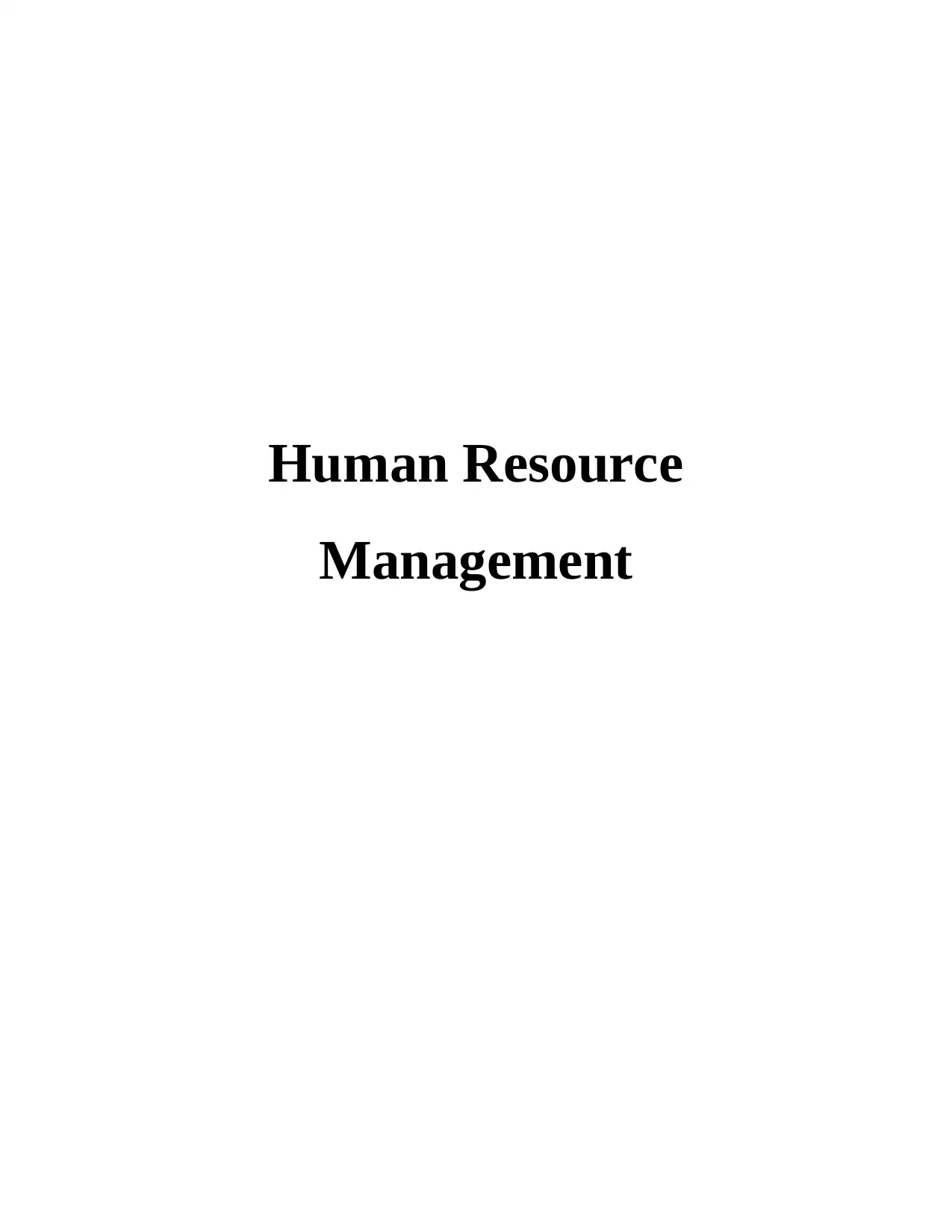
Human Resource
Management
Management
Paraphrase This Document
Need a fresh take? Get an instant paraphrase of this document with our AI Paraphraser
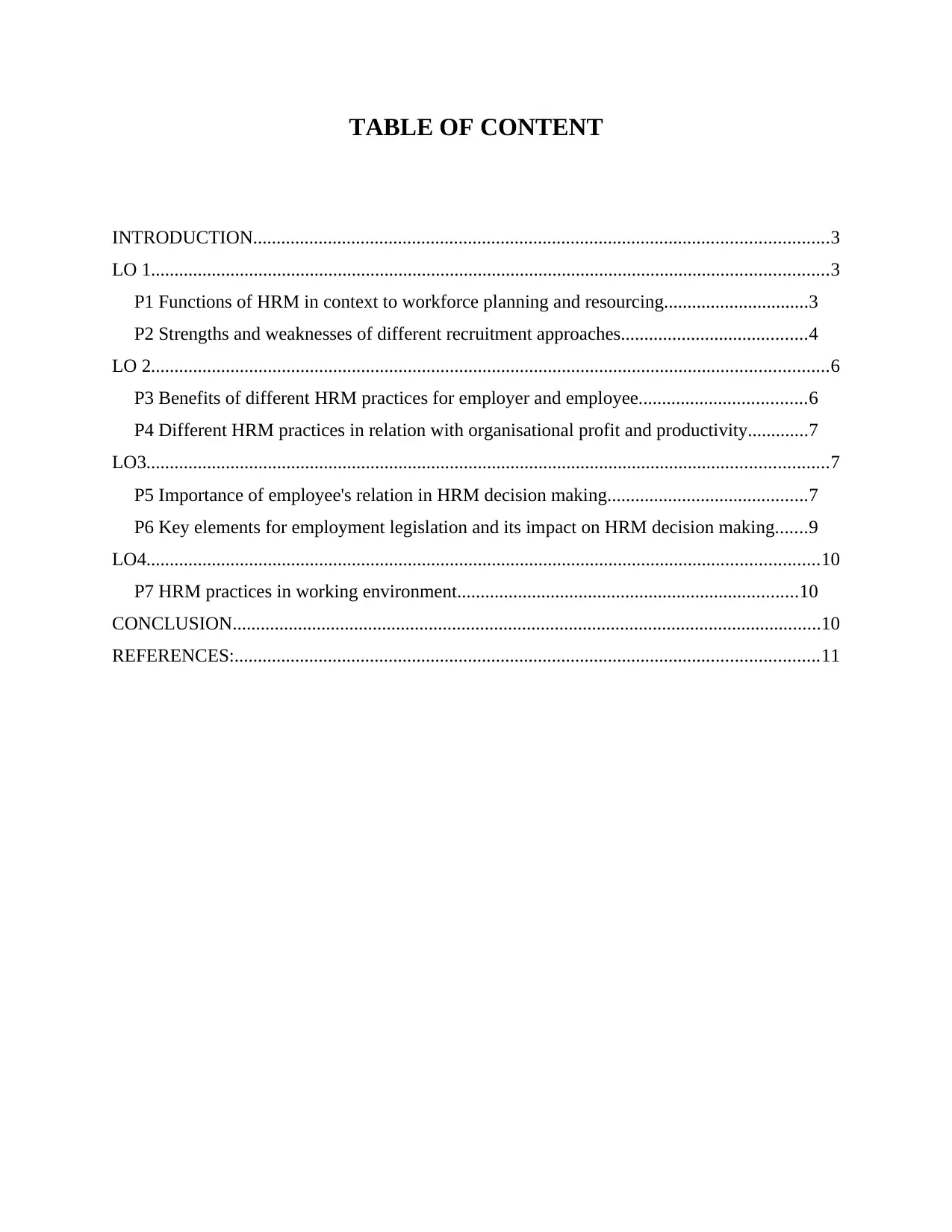
TABLE OF CONTENT
INTRODUCTION...........................................................................................................................3
LO 1.................................................................................................................................................3
P1 Functions of HRM in context to workforce planning and resourcing...............................3
P2 Strengths and weaknesses of different recruitment approaches........................................4
LO 2.................................................................................................................................................6
P3 Benefits of different HRM practices for employer and employee....................................6
P4 Different HRM practices in relation with organisational profit and productivity.............7
LO3..................................................................................................................................................7
P5 Importance of employee's relation in HRM decision making...........................................7
P6 Key elements for employment legislation and its impact on HRM decision making.......9
LO4................................................................................................................................................10
P7 HRM practices in working environment.........................................................................10
CONCLUSION..............................................................................................................................10
REFERENCES:.............................................................................................................................11
INTRODUCTION...........................................................................................................................3
LO 1.................................................................................................................................................3
P1 Functions of HRM in context to workforce planning and resourcing...............................3
P2 Strengths and weaknesses of different recruitment approaches........................................4
LO 2.................................................................................................................................................6
P3 Benefits of different HRM practices for employer and employee....................................6
P4 Different HRM practices in relation with organisational profit and productivity.............7
LO3..................................................................................................................................................7
P5 Importance of employee's relation in HRM decision making...........................................7
P6 Key elements for employment legislation and its impact on HRM decision making.......9
LO4................................................................................................................................................10
P7 HRM practices in working environment.........................................................................10
CONCLUSION..............................................................................................................................10
REFERENCES:.............................................................................................................................11
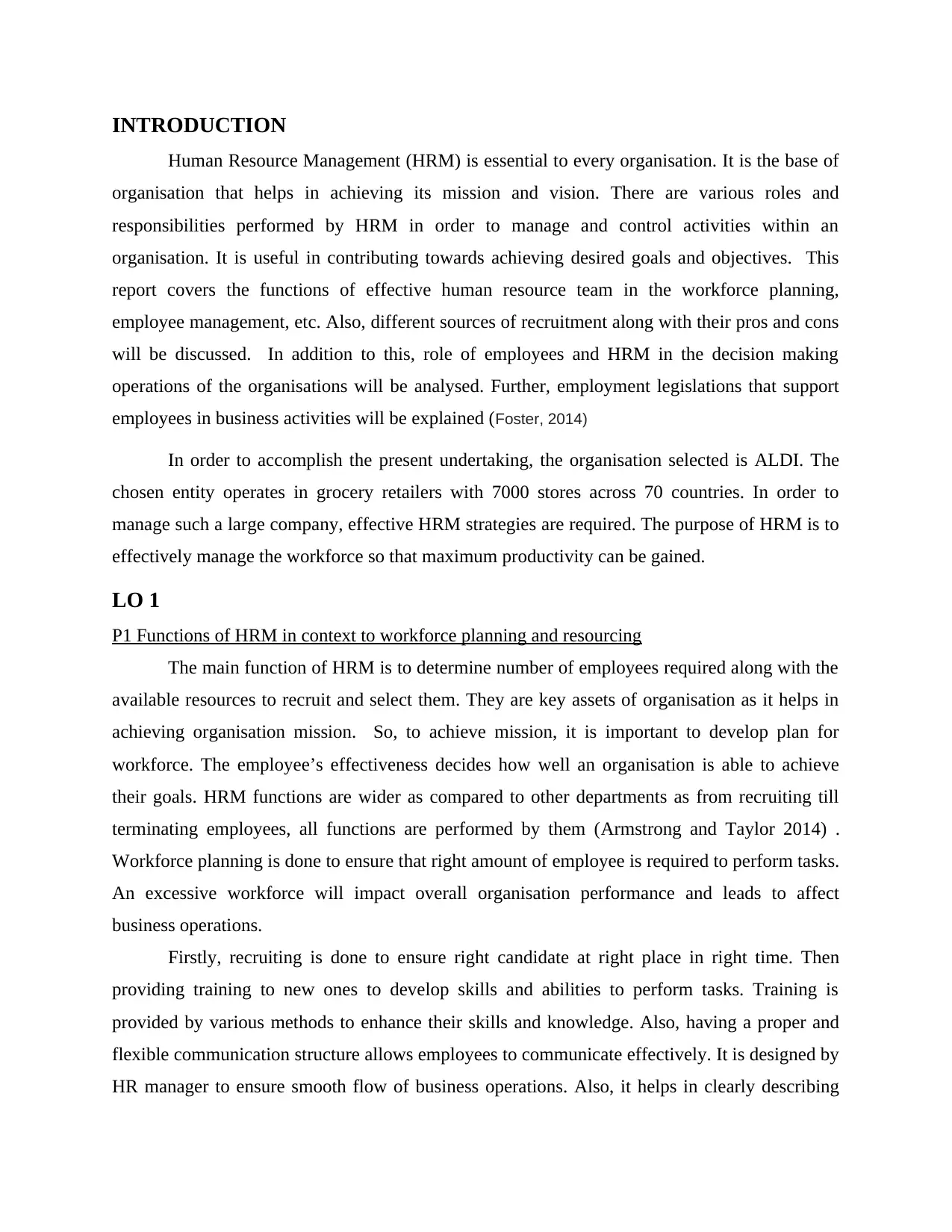
INTRODUCTION
Human Resource Management (HRM) is essential to every organisation. It is the base of
organisation that helps in achieving its mission and vision. There are various roles and
responsibilities performed by HRM in order to manage and control activities within an
organisation. It is useful in contributing towards achieving desired goals and objectives. This
report covers the functions of effective human resource team in the workforce planning,
employee management, etc. Also, different sources of recruitment along with their pros and cons
will be discussed. In addition to this, role of employees and HRM in the decision making
operations of the organisations will be analysed. Further, employment legislations that support
employees in business activities will be explained (Foster, 2014)
In order to accomplish the present undertaking, the organisation selected is ALDI. The
chosen entity operates in grocery retailers with 7000 stores across 70 countries. In order to
manage such a large company, effective HRM strategies are required. The purpose of HRM is to
effectively manage the workforce so that maximum productivity can be gained.
LO 1
P1 Functions of HRM in context to workforce planning and resourcing
The main function of HRM is to determine number of employees required along with the
available resources to recruit and select them. They are key assets of organisation as it helps in
achieving organisation mission. So, to achieve mission, it is important to develop plan for
workforce. The employee’s effectiveness decides how well an organisation is able to achieve
their goals. HRM functions are wider as compared to other departments as from recruiting till
terminating employees, all functions are performed by them (Armstrong and Taylor 2014) .
Workforce planning is done to ensure that right amount of employee is required to perform tasks.
An excessive workforce will impact overall organisation performance and leads to affect
business operations.
Firstly, recruiting is done to ensure right candidate at right place in right time. Then
providing training to new ones to develop skills and abilities to perform tasks. Training is
provided by various methods to enhance their skills and knowledge. Also, having a proper and
flexible communication structure allows employees to communicate effectively. It is designed by
HR manager to ensure smooth flow of business operations. Also, it helps in clearly describing
Human Resource Management (HRM) is essential to every organisation. It is the base of
organisation that helps in achieving its mission and vision. There are various roles and
responsibilities performed by HRM in order to manage and control activities within an
organisation. It is useful in contributing towards achieving desired goals and objectives. This
report covers the functions of effective human resource team in the workforce planning,
employee management, etc. Also, different sources of recruitment along with their pros and cons
will be discussed. In addition to this, role of employees and HRM in the decision making
operations of the organisations will be analysed. Further, employment legislations that support
employees in business activities will be explained (Foster, 2014)
In order to accomplish the present undertaking, the organisation selected is ALDI. The
chosen entity operates in grocery retailers with 7000 stores across 70 countries. In order to
manage such a large company, effective HRM strategies are required. The purpose of HRM is to
effectively manage the workforce so that maximum productivity can be gained.
LO 1
P1 Functions of HRM in context to workforce planning and resourcing
The main function of HRM is to determine number of employees required along with the
available resources to recruit and select them. They are key assets of organisation as it helps in
achieving organisation mission. So, to achieve mission, it is important to develop plan for
workforce. The employee’s effectiveness decides how well an organisation is able to achieve
their goals. HRM functions are wider as compared to other departments as from recruiting till
terminating employees, all functions are performed by them (Armstrong and Taylor 2014) .
Workforce planning is done to ensure that right amount of employee is required to perform tasks.
An excessive workforce will impact overall organisation performance and leads to affect
business operations.
Firstly, recruiting is done to ensure right candidate at right place in right time. Then
providing training to new ones to develop skills and abilities to perform tasks. Training is
provided by various methods to enhance their skills and knowledge. Also, having a proper and
flexible communication structure allows employees to communicate effectively. It is designed by
HR manager to ensure smooth flow of business operations. Also, it helps in clearly describing
⊘ This is a preview!⊘
Do you want full access?
Subscribe today to unlock all pages.

Trusted by 1+ million students worldwide
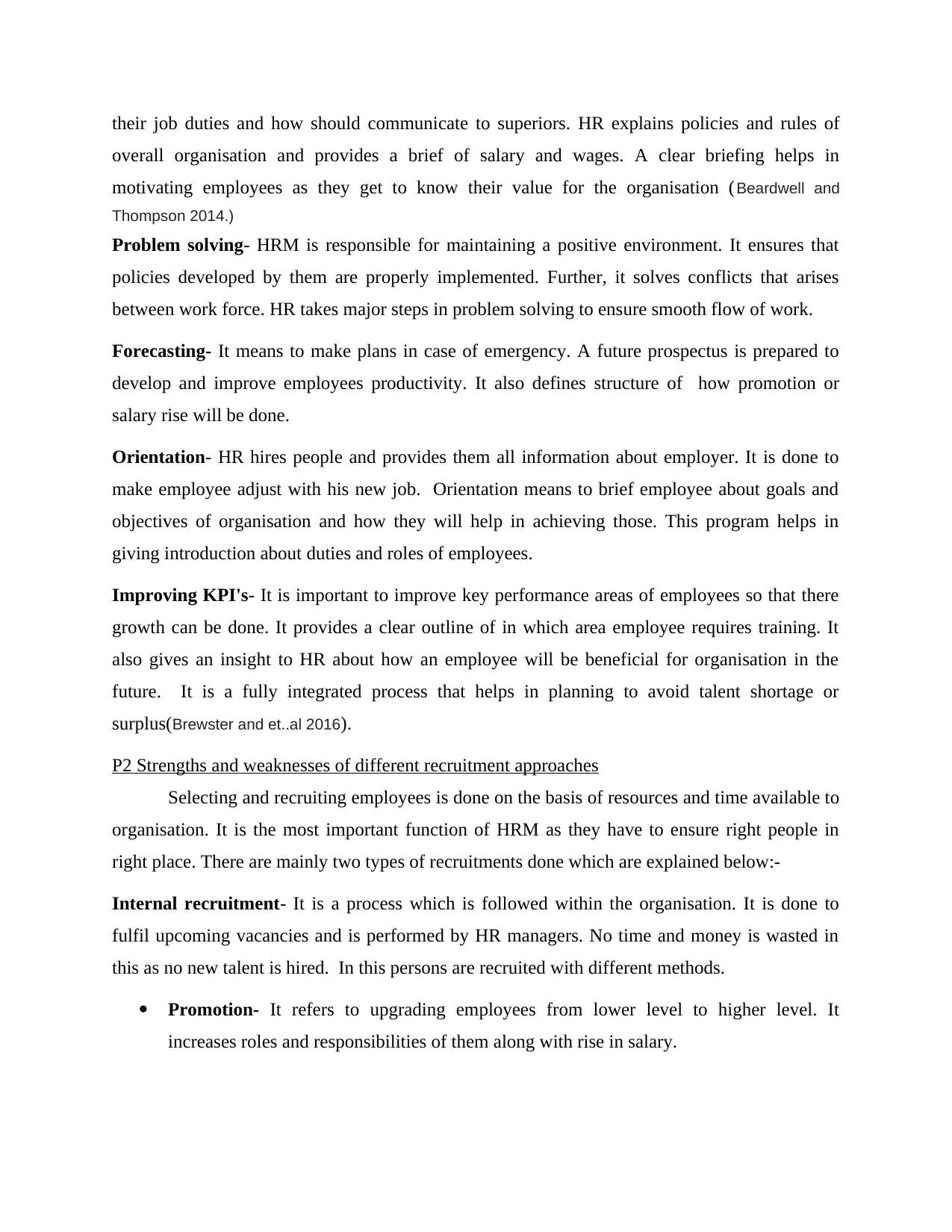
their job duties and how should communicate to superiors. HR explains policies and rules of
overall organisation and provides a brief of salary and wages. A clear briefing helps in
motivating employees as they get to know their value for the organisation (Beardwell and
Thompson 2014.)
Problem solving- HRM is responsible for maintaining a positive environment. It ensures that
policies developed by them are properly implemented. Further, it solves conflicts that arises
between work force. HR takes major steps in problem solving to ensure smooth flow of work.
Forecasting- It means to make plans in case of emergency. A future prospectus is prepared to
develop and improve employees productivity. It also defines structure of how promotion or
salary rise will be done.
Orientation- HR hires people and provides them all information about employer. It is done to
make employee adjust with his new job. Orientation means to brief employee about goals and
objectives of organisation and how they will help in achieving those. This program helps in
giving introduction about duties and roles of employees.
Improving KPI's- It is important to improve key performance areas of employees so that there
growth can be done. It provides a clear outline of in which area employee requires training. It
also gives an insight to HR about how an employee will be beneficial for organisation in the
future. It is a fully integrated process that helps in planning to avoid talent shortage or
surplus(Brewster and et..al 2016).
P2 Strengths and weaknesses of different recruitment approaches
Selecting and recruiting employees is done on the basis of resources and time available to
organisation. It is the most important function of HRM as they have to ensure right people in
right place. There are mainly two types of recruitments done which are explained below:-
Internal recruitment- It is a process which is followed within the organisation. It is done to
fulfil upcoming vacancies and is performed by HR managers. No time and money is wasted in
this as no new talent is hired. In this persons are recruited with different methods.
Promotion- It refers to upgrading employees from lower level to higher level. It
increases roles and responsibilities of them along with rise in salary.
overall organisation and provides a brief of salary and wages. A clear briefing helps in
motivating employees as they get to know their value for the organisation (Beardwell and
Thompson 2014.)
Problem solving- HRM is responsible for maintaining a positive environment. It ensures that
policies developed by them are properly implemented. Further, it solves conflicts that arises
between work force. HR takes major steps in problem solving to ensure smooth flow of work.
Forecasting- It means to make plans in case of emergency. A future prospectus is prepared to
develop and improve employees productivity. It also defines structure of how promotion or
salary rise will be done.
Orientation- HR hires people and provides them all information about employer. It is done to
make employee adjust with his new job. Orientation means to brief employee about goals and
objectives of organisation and how they will help in achieving those. This program helps in
giving introduction about duties and roles of employees.
Improving KPI's- It is important to improve key performance areas of employees so that there
growth can be done. It provides a clear outline of in which area employee requires training. It
also gives an insight to HR about how an employee will be beneficial for organisation in the
future. It is a fully integrated process that helps in planning to avoid talent shortage or
surplus(Brewster and et..al 2016).
P2 Strengths and weaknesses of different recruitment approaches
Selecting and recruiting employees is done on the basis of resources and time available to
organisation. It is the most important function of HRM as they have to ensure right people in
right place. There are mainly two types of recruitments done which are explained below:-
Internal recruitment- It is a process which is followed within the organisation. It is done to
fulfil upcoming vacancies and is performed by HR managers. No time and money is wasted in
this as no new talent is hired. In this persons are recruited with different methods.
Promotion- It refers to upgrading employees from lower level to higher level. It
increases roles and responsibilities of them along with rise in salary.
Paraphrase This Document
Need a fresh take? Get an instant paraphrase of this document with our AI Paraphraser
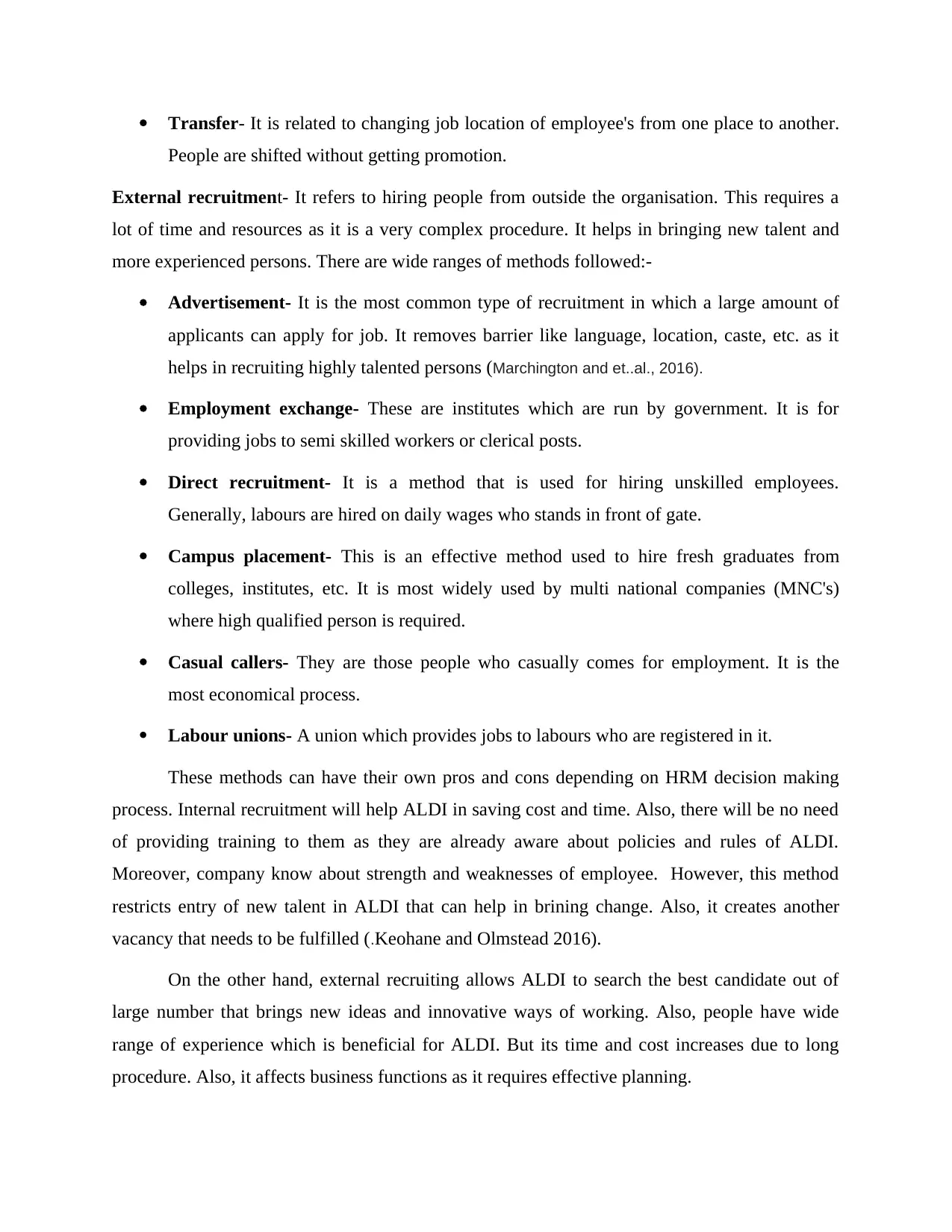
Transfer- It is related to changing job location of employee's from one place to another.
People are shifted without getting promotion.
External recruitment- It refers to hiring people from outside the organisation. This requires a
lot of time and resources as it is a very complex procedure. It helps in bringing new talent and
more experienced persons. There are wide ranges of methods followed:-
Advertisement- It is the most common type of recruitment in which a large amount of
applicants can apply for job. It removes barrier like language, location, caste, etc. as it
helps in recruiting highly talented persons (Marchington and et..al., 2016).
Employment exchange- These are institutes which are run by government. It is for
providing jobs to semi skilled workers or clerical posts.
Direct recruitment- It is a method that is used for hiring unskilled employees.
Generally, labours are hired on daily wages who stands in front of gate.
Campus placement- This is an effective method used to hire fresh graduates from
colleges, institutes, etc. It is most widely used by multi national companies (MNC's)
where high qualified person is required.
Casual callers- They are those people who casually comes for employment. It is the
most economical process.
Labour unions- A union which provides jobs to labours who are registered in it.
These methods can have their own pros and cons depending on HRM decision making
process. Internal recruitment will help ALDI in saving cost and time. Also, there will be no need
of providing training to them as they are already aware about policies and rules of ALDI.
Moreover, company know about strength and weaknesses of employee. However, this method
restricts entry of new talent in ALDI that can help in brining change. Also, it creates another
vacancy that needs to be fulfilled (.Keohane and Olmstead 2016).
On the other hand, external recruiting allows ALDI to search the best candidate out of
large number that brings new ideas and innovative ways of working. Also, people have wide
range of experience which is beneficial for ALDI. But its time and cost increases due to long
procedure. Also, it affects business functions as it requires effective planning.
People are shifted without getting promotion.
External recruitment- It refers to hiring people from outside the organisation. This requires a
lot of time and resources as it is a very complex procedure. It helps in bringing new talent and
more experienced persons. There are wide ranges of methods followed:-
Advertisement- It is the most common type of recruitment in which a large amount of
applicants can apply for job. It removes barrier like language, location, caste, etc. as it
helps in recruiting highly talented persons (Marchington and et..al., 2016).
Employment exchange- These are institutes which are run by government. It is for
providing jobs to semi skilled workers or clerical posts.
Direct recruitment- It is a method that is used for hiring unskilled employees.
Generally, labours are hired on daily wages who stands in front of gate.
Campus placement- This is an effective method used to hire fresh graduates from
colleges, institutes, etc. It is most widely used by multi national companies (MNC's)
where high qualified person is required.
Casual callers- They are those people who casually comes for employment. It is the
most economical process.
Labour unions- A union which provides jobs to labours who are registered in it.
These methods can have their own pros and cons depending on HRM decision making
process. Internal recruitment will help ALDI in saving cost and time. Also, there will be no need
of providing training to them as they are already aware about policies and rules of ALDI.
Moreover, company know about strength and weaknesses of employee. However, this method
restricts entry of new talent in ALDI that can help in brining change. Also, it creates another
vacancy that needs to be fulfilled (.Keohane and Olmstead 2016).
On the other hand, external recruiting allows ALDI to search the best candidate out of
large number that brings new ideas and innovative ways of working. Also, people have wide
range of experience which is beneficial for ALDI. But its time and cost increases due to long
procedure. Also, it affects business functions as it requires effective planning.
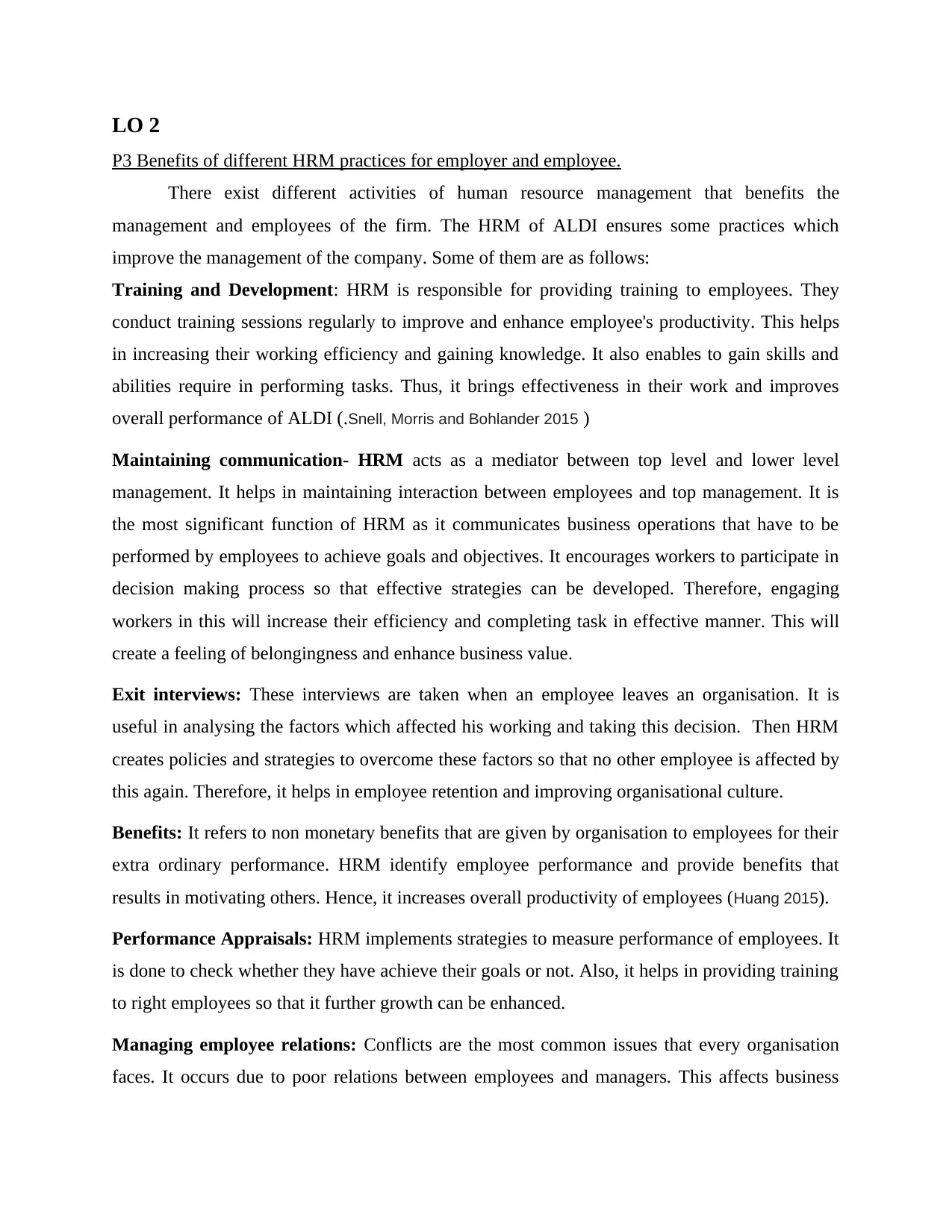
LO 2
P3 Benefits of different HRM practices for employer and employee.
There exist different activities of human resource management that benefits the
management and employees of the firm. The HRM of ALDI ensures some practices which
improve the management of the company. Some of them are as follows:
Training and Development: HRM is responsible for providing training to employees. They
conduct training sessions regularly to improve and enhance employee's productivity. This helps
in increasing their working efficiency and gaining knowledge. It also enables to gain skills and
abilities require in performing tasks. Thus, it brings effectiveness in their work and improves
overall performance of ALDI (.Snell, Morris and Bohlander 2015 )
Maintaining communication- HRM acts as a mediator between top level and lower level
management. It helps in maintaining interaction between employees and top management. It is
the most significant function of HRM as it communicates business operations that have to be
performed by employees to achieve goals and objectives. It encourages workers to participate in
decision making process so that effective strategies can be developed. Therefore, engaging
workers in this will increase their efficiency and completing task in effective manner. This will
create a feeling of belongingness and enhance business value.
Exit interviews: These interviews are taken when an employee leaves an organisation. It is
useful in analysing the factors which affected his working and taking this decision. Then HRM
creates policies and strategies to overcome these factors so that no other employee is affected by
this again. Therefore, it helps in employee retention and improving organisational culture.
Benefits: It refers to non monetary benefits that are given by organisation to employees for their
extra ordinary performance. HRM identify employee performance and provide benefits that
results in motivating others. Hence, it increases overall productivity of employees (Huang 2015).
Performance Appraisals: HRM implements strategies to measure performance of employees. It
is done to check whether they have achieve their goals or not. Also, it helps in providing training
to right employees so that it further growth can be enhanced.
Managing employee relations: Conflicts are the most common issues that every organisation
faces. It occurs due to poor relations between employees and managers. This affects business
P3 Benefits of different HRM practices for employer and employee.
There exist different activities of human resource management that benefits the
management and employees of the firm. The HRM of ALDI ensures some practices which
improve the management of the company. Some of them are as follows:
Training and Development: HRM is responsible for providing training to employees. They
conduct training sessions regularly to improve and enhance employee's productivity. This helps
in increasing their working efficiency and gaining knowledge. It also enables to gain skills and
abilities require in performing tasks. Thus, it brings effectiveness in their work and improves
overall performance of ALDI (.Snell, Morris and Bohlander 2015 )
Maintaining communication- HRM acts as a mediator between top level and lower level
management. It helps in maintaining interaction between employees and top management. It is
the most significant function of HRM as it communicates business operations that have to be
performed by employees to achieve goals and objectives. It encourages workers to participate in
decision making process so that effective strategies can be developed. Therefore, engaging
workers in this will increase their efficiency and completing task in effective manner. This will
create a feeling of belongingness and enhance business value.
Exit interviews: These interviews are taken when an employee leaves an organisation. It is
useful in analysing the factors which affected his working and taking this decision. Then HRM
creates policies and strategies to overcome these factors so that no other employee is affected by
this again. Therefore, it helps in employee retention and improving organisational culture.
Benefits: It refers to non monetary benefits that are given by organisation to employees for their
extra ordinary performance. HRM identify employee performance and provide benefits that
results in motivating others. Hence, it increases overall productivity of employees (Huang 2015).
Performance Appraisals: HRM implements strategies to measure performance of employees. It
is done to check whether they have achieve their goals or not. Also, it helps in providing training
to right employees so that it further growth can be enhanced.
Managing employee relations: Conflicts are the most common issues that every organisation
faces. It occurs due to poor relations between employees and managers. This affects business
⊘ This is a preview!⊘
Do you want full access?
Subscribe today to unlock all pages.

Trusted by 1+ million students worldwide
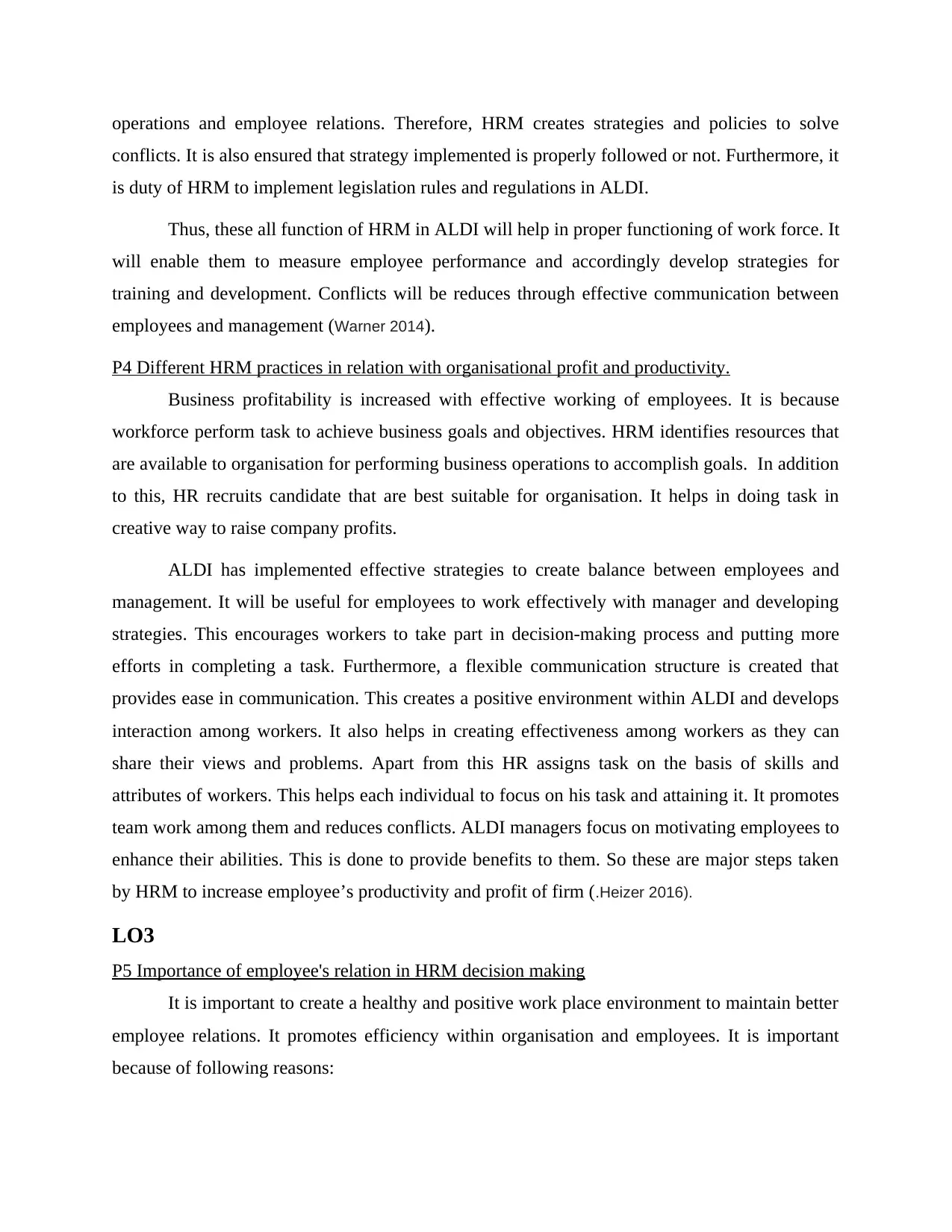
operations and employee relations. Therefore, HRM creates strategies and policies to solve
conflicts. It is also ensured that strategy implemented is properly followed or not. Furthermore, it
is duty of HRM to implement legislation rules and regulations in ALDI.
Thus, these all function of HRM in ALDI will help in proper functioning of work force. It
will enable them to measure employee performance and accordingly develop strategies for
training and development. Conflicts will be reduces through effective communication between
employees and management (Warner 2014).
P4 Different HRM practices in relation with organisational profit and productivity.
Business profitability is increased with effective working of employees. It is because
workforce perform task to achieve business goals and objectives. HRM identifies resources that
are available to organisation for performing business operations to accomplish goals. In addition
to this, HR recruits candidate that are best suitable for organisation. It helps in doing task in
creative way to raise company profits.
ALDI has implemented effective strategies to create balance between employees and
management. It will be useful for employees to work effectively with manager and developing
strategies. This encourages workers to take part in decision-making process and putting more
efforts in completing a task. Furthermore, a flexible communication structure is created that
provides ease in communication. This creates a positive environment within ALDI and develops
interaction among workers. It also helps in creating effectiveness among workers as they can
share their views and problems. Apart from this HR assigns task on the basis of skills and
attributes of workers. This helps each individual to focus on his task and attaining it. It promotes
team work among them and reduces conflicts. ALDI managers focus on motivating employees to
enhance their abilities. This is done to provide benefits to them. So these are major steps taken
by HRM to increase employee’s productivity and profit of firm (.Heizer 2016).
LO3
P5 Importance of employee's relation in HRM decision making
It is important to create a healthy and positive work place environment to maintain better
employee relations. It promotes efficiency within organisation and employees. It is important
because of following reasons:
conflicts. It is also ensured that strategy implemented is properly followed or not. Furthermore, it
is duty of HRM to implement legislation rules and regulations in ALDI.
Thus, these all function of HRM in ALDI will help in proper functioning of work force. It
will enable them to measure employee performance and accordingly develop strategies for
training and development. Conflicts will be reduces through effective communication between
employees and management (Warner 2014).
P4 Different HRM practices in relation with organisational profit and productivity.
Business profitability is increased with effective working of employees. It is because
workforce perform task to achieve business goals and objectives. HRM identifies resources that
are available to organisation for performing business operations to accomplish goals. In addition
to this, HR recruits candidate that are best suitable for organisation. It helps in doing task in
creative way to raise company profits.
ALDI has implemented effective strategies to create balance between employees and
management. It will be useful for employees to work effectively with manager and developing
strategies. This encourages workers to take part in decision-making process and putting more
efforts in completing a task. Furthermore, a flexible communication structure is created that
provides ease in communication. This creates a positive environment within ALDI and develops
interaction among workers. It also helps in creating effectiveness among workers as they can
share their views and problems. Apart from this HR assigns task on the basis of skills and
attributes of workers. This helps each individual to focus on his task and attaining it. It promotes
team work among them and reduces conflicts. ALDI managers focus on motivating employees to
enhance their abilities. This is done to provide benefits to them. So these are major steps taken
by HRM to increase employee’s productivity and profit of firm (.Heizer 2016).
LO3
P5 Importance of employee's relation in HRM decision making
It is important to create a healthy and positive work place environment to maintain better
employee relations. It promotes efficiency within organisation and employees. It is important
because of following reasons:
Paraphrase This Document
Need a fresh take? Get an instant paraphrase of this document with our AI Paraphraser
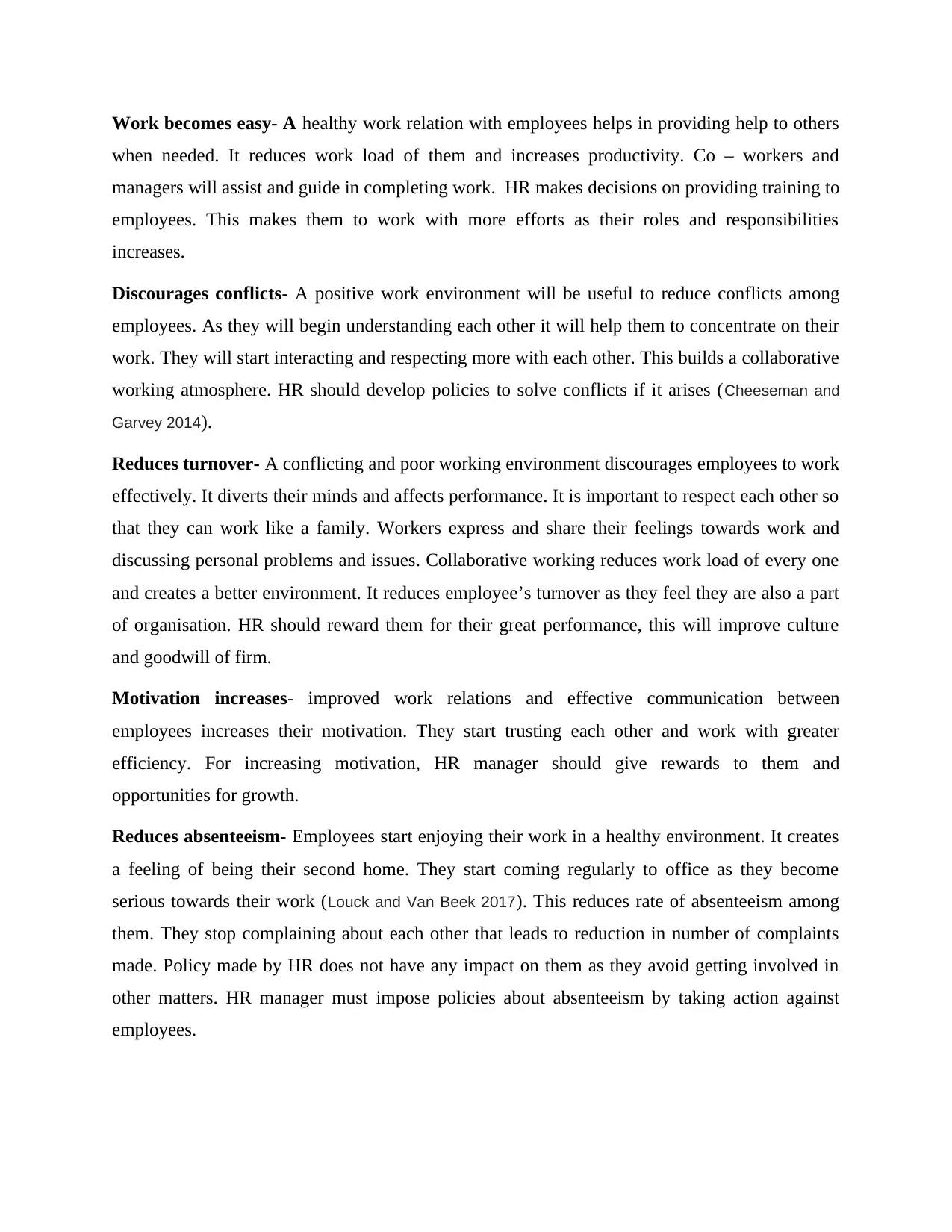
Work becomes easy- A healthy work relation with employees helps in providing help to others
when needed. It reduces work load of them and increases productivity. Co – workers and
managers will assist and guide in completing work. HR makes decisions on providing training to
employees. This makes them to work with more efforts as their roles and responsibilities
increases.
Discourages conflicts- A positive work environment will be useful to reduce conflicts among
employees. As they will begin understanding each other it will help them to concentrate on their
work. They will start interacting and respecting more with each other. This builds a collaborative
working atmosphere. HR should develop policies to solve conflicts if it arises (Cheeseman and
Garvey 2014).
Reduces turnover- A conflicting and poor working environment discourages employees to work
effectively. It diverts their minds and affects performance. It is important to respect each other so
that they can work like a family. Workers express and share their feelings towards work and
discussing personal problems and issues. Collaborative working reduces work load of every one
and creates a better environment. It reduces employee’s turnover as they feel they are also a part
of organisation. HR should reward them for their great performance, this will improve culture
and goodwill of firm.
Motivation increases- improved work relations and effective communication between
employees increases their motivation. They start trusting each other and work with greater
efficiency. For increasing motivation, HR manager should give rewards to them and
opportunities for growth.
Reduces absenteeism- Employees start enjoying their work in a healthy environment. It creates
a feeling of being their second home. They start coming regularly to office as they become
serious towards their work (Louck and Van Beek 2017). This reduces rate of absenteeism among
them. They stop complaining about each other that leads to reduction in number of complaints
made. Policy made by HR does not have any impact on them as they avoid getting involved in
other matters. HR manager must impose policies about absenteeism by taking action against
employees.
when needed. It reduces work load of them and increases productivity. Co – workers and
managers will assist and guide in completing work. HR makes decisions on providing training to
employees. This makes them to work with more efforts as their roles and responsibilities
increases.
Discourages conflicts- A positive work environment will be useful to reduce conflicts among
employees. As they will begin understanding each other it will help them to concentrate on their
work. They will start interacting and respecting more with each other. This builds a collaborative
working atmosphere. HR should develop policies to solve conflicts if it arises (Cheeseman and
Garvey 2014).
Reduces turnover- A conflicting and poor working environment discourages employees to work
effectively. It diverts their minds and affects performance. It is important to respect each other so
that they can work like a family. Workers express and share their feelings towards work and
discussing personal problems and issues. Collaborative working reduces work load of every one
and creates a better environment. It reduces employee’s turnover as they feel they are also a part
of organisation. HR should reward them for their great performance, this will improve culture
and goodwill of firm.
Motivation increases- improved work relations and effective communication between
employees increases their motivation. They start trusting each other and work with greater
efficiency. For increasing motivation, HR manager should give rewards to them and
opportunities for growth.
Reduces absenteeism- Employees start enjoying their work in a healthy environment. It creates
a feeling of being their second home. They start coming regularly to office as they become
serious towards their work (Louck and Van Beek 2017). This reduces rate of absenteeism among
them. They stop complaining about each other that leads to reduction in number of complaints
made. Policy made by HR does not have any impact on them as they avoid getting involved in
other matters. HR manager must impose policies about absenteeism by taking action against
employees.
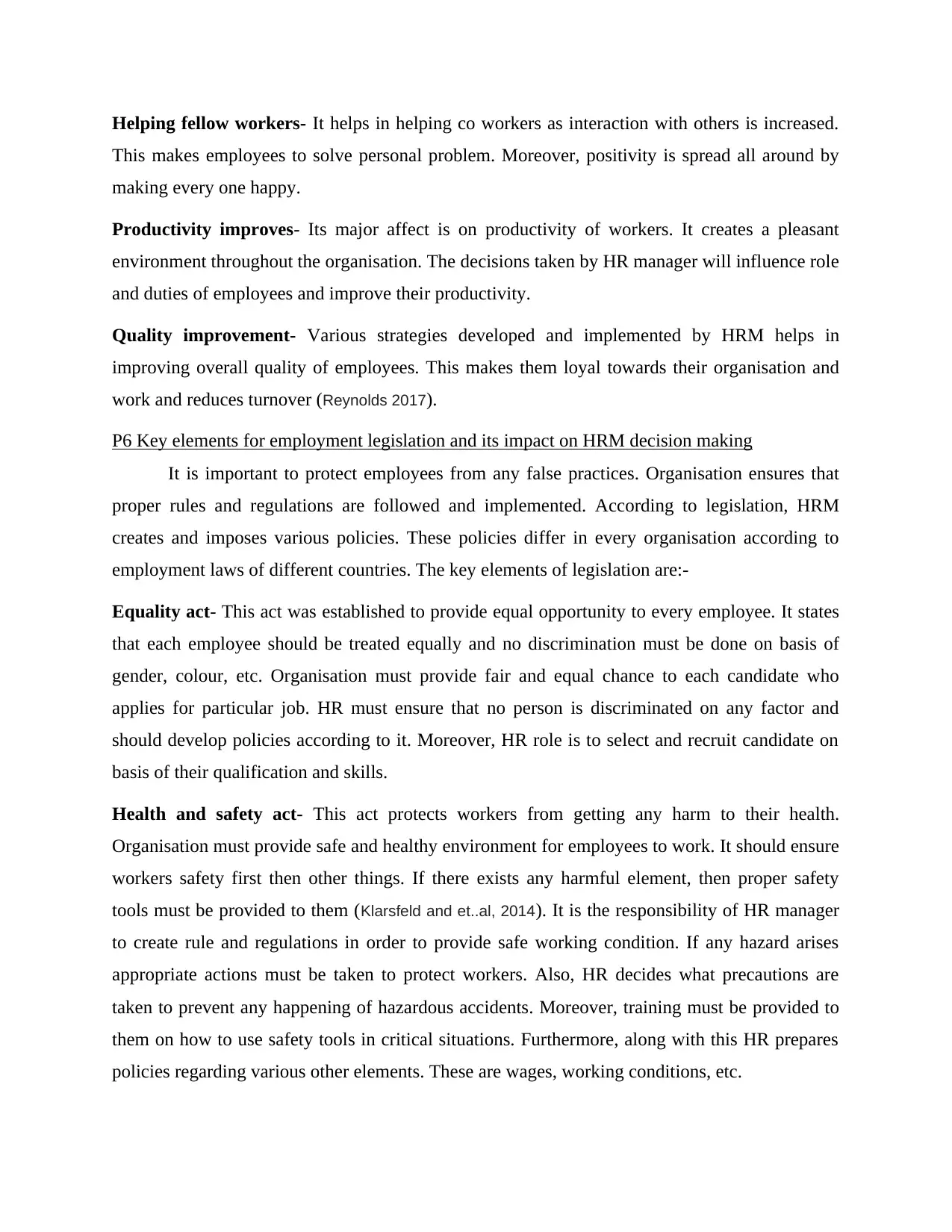
Helping fellow workers- It helps in helping co workers as interaction with others is increased.
This makes employees to solve personal problem. Moreover, positivity is spread all around by
making every one happy.
Productivity improves- Its major affect is on productivity of workers. It creates a pleasant
environment throughout the organisation. The decisions taken by HR manager will influence role
and duties of employees and improve their productivity.
Quality improvement- Various strategies developed and implemented by HRM helps in
improving overall quality of employees. This makes them loyal towards their organisation and
work and reduces turnover (Reynolds 2017).
P6 Key elements for employment legislation and its impact on HRM decision making
It is important to protect employees from any false practices. Organisation ensures that
proper rules and regulations are followed and implemented. According to legislation, HRM
creates and imposes various policies. These policies differ in every organisation according to
employment laws of different countries. The key elements of legislation are:-
Equality act- This act was established to provide equal opportunity to every employee. It states
that each employee should be treated equally and no discrimination must be done on basis of
gender, colour, etc. Organisation must provide fair and equal chance to each candidate who
applies for particular job. HR must ensure that no person is discriminated on any factor and
should develop policies according to it. Moreover, HR role is to select and recruit candidate on
basis of their qualification and skills.
Health and safety act- This act protects workers from getting any harm to their health.
Organisation must provide safe and healthy environment for employees to work. It should ensure
workers safety first then other things. If there exists any harmful element, then proper safety
tools must be provided to them (Klarsfeld and et..al, 2014). It is the responsibility of HR manager
to create rule and regulations in order to provide safe working condition. If any hazard arises
appropriate actions must be taken to protect workers. Also, HR decides what precautions are
taken to prevent any happening of hazardous accidents. Moreover, training must be provided to
them on how to use safety tools in critical situations. Furthermore, along with this HR prepares
policies regarding various other elements. These are wages, working conditions, etc.
This makes employees to solve personal problem. Moreover, positivity is spread all around by
making every one happy.
Productivity improves- Its major affect is on productivity of workers. It creates a pleasant
environment throughout the organisation. The decisions taken by HR manager will influence role
and duties of employees and improve their productivity.
Quality improvement- Various strategies developed and implemented by HRM helps in
improving overall quality of employees. This makes them loyal towards their organisation and
work and reduces turnover (Reynolds 2017).
P6 Key elements for employment legislation and its impact on HRM decision making
It is important to protect employees from any false practices. Organisation ensures that
proper rules and regulations are followed and implemented. According to legislation, HRM
creates and imposes various policies. These policies differ in every organisation according to
employment laws of different countries. The key elements of legislation are:-
Equality act- This act was established to provide equal opportunity to every employee. It states
that each employee should be treated equally and no discrimination must be done on basis of
gender, colour, etc. Organisation must provide fair and equal chance to each candidate who
applies for particular job. HR must ensure that no person is discriminated on any factor and
should develop policies according to it. Moreover, HR role is to select and recruit candidate on
basis of their qualification and skills.
Health and safety act- This act protects workers from getting any harm to their health.
Organisation must provide safe and healthy environment for employees to work. It should ensure
workers safety first then other things. If there exists any harmful element, then proper safety
tools must be provided to them (Klarsfeld and et..al, 2014). It is the responsibility of HR manager
to create rule and regulations in order to provide safe working condition. If any hazard arises
appropriate actions must be taken to protect workers. Also, HR decides what precautions are
taken to prevent any happening of hazardous accidents. Moreover, training must be provided to
them on how to use safety tools in critical situations. Furthermore, along with this HR prepares
policies regarding various other elements. These are wages, working conditions, etc.
⊘ This is a preview!⊘
Do you want full access?
Subscribe today to unlock all pages.

Trusted by 1+ million students worldwide
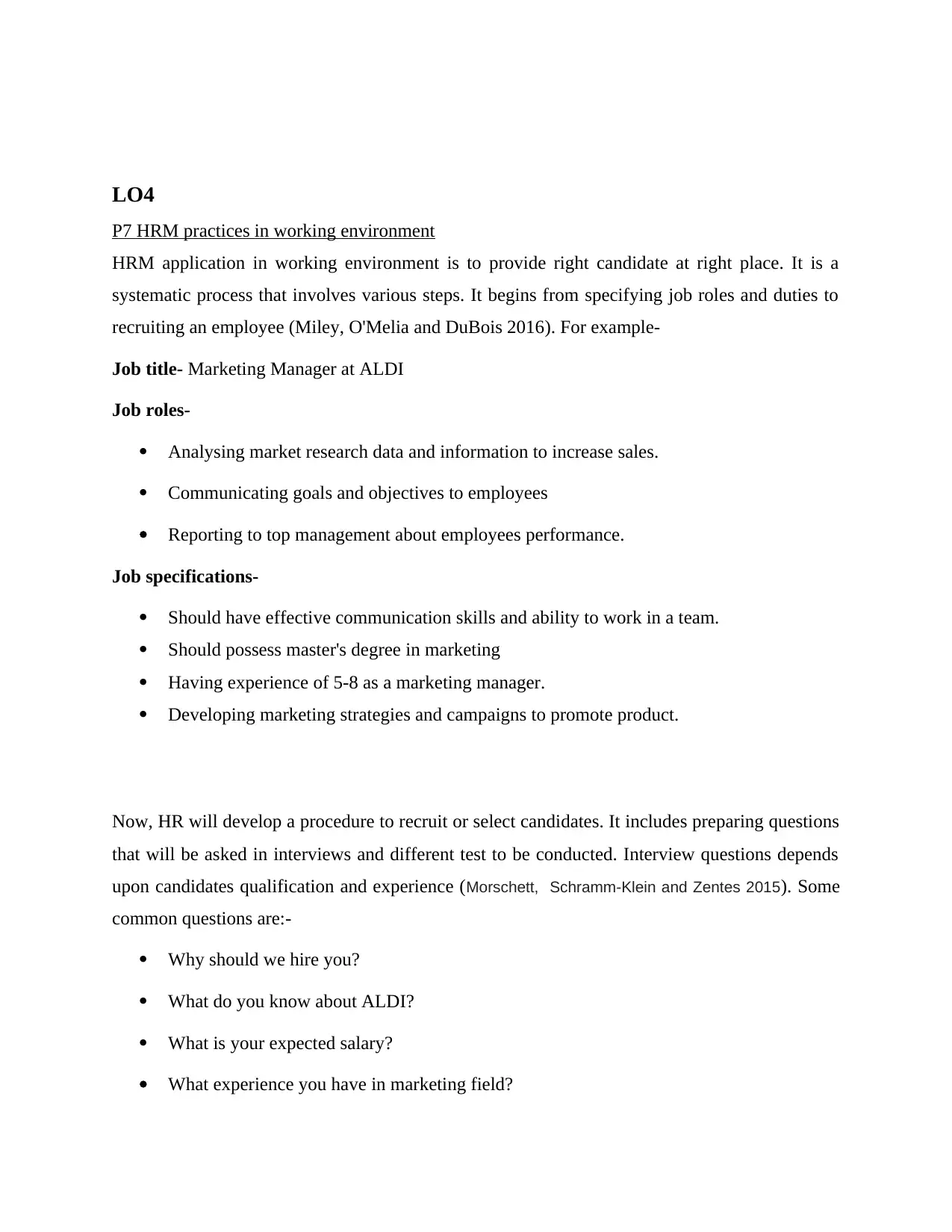
LO4
P7 HRM practices in working environment
HRM application in working environment is to provide right candidate at right place. It is a
systematic process that involves various steps. It begins from specifying job roles and duties to
recruiting an employee (Miley, O'Melia and DuBois 2016). For example-
Job title- Marketing Manager at ALDI
Job roles-
Analysing market research data and information to increase sales.
Communicating goals and objectives to employees
Reporting to top management about employees performance.
Job specifications-
Should have effective communication skills and ability to work in a team.
Should possess master's degree in marketing
Having experience of 5-8 as a marketing manager.
Developing marketing strategies and campaigns to promote product.
Now, HR will develop a procedure to recruit or select candidates. It includes preparing questions
that will be asked in interviews and different test to be conducted. Interview questions depends
upon candidates qualification and experience (Morschett, Schramm-Klein and Zentes 2015). Some
common questions are:-
Why should we hire you?
What do you know about ALDI?
What is your expected salary?
What experience you have in marketing field?
P7 HRM practices in working environment
HRM application in working environment is to provide right candidate at right place. It is a
systematic process that involves various steps. It begins from specifying job roles and duties to
recruiting an employee (Miley, O'Melia and DuBois 2016). For example-
Job title- Marketing Manager at ALDI
Job roles-
Analysing market research data and information to increase sales.
Communicating goals and objectives to employees
Reporting to top management about employees performance.
Job specifications-
Should have effective communication skills and ability to work in a team.
Should possess master's degree in marketing
Having experience of 5-8 as a marketing manager.
Developing marketing strategies and campaigns to promote product.
Now, HR will develop a procedure to recruit or select candidates. It includes preparing questions
that will be asked in interviews and different test to be conducted. Interview questions depends
upon candidates qualification and experience (Morschett, Schramm-Klein and Zentes 2015). Some
common questions are:-
Why should we hire you?
What do you know about ALDI?
What is your expected salary?
What experience you have in marketing field?
Paraphrase This Document
Need a fresh take? Get an instant paraphrase of this document with our AI Paraphraser
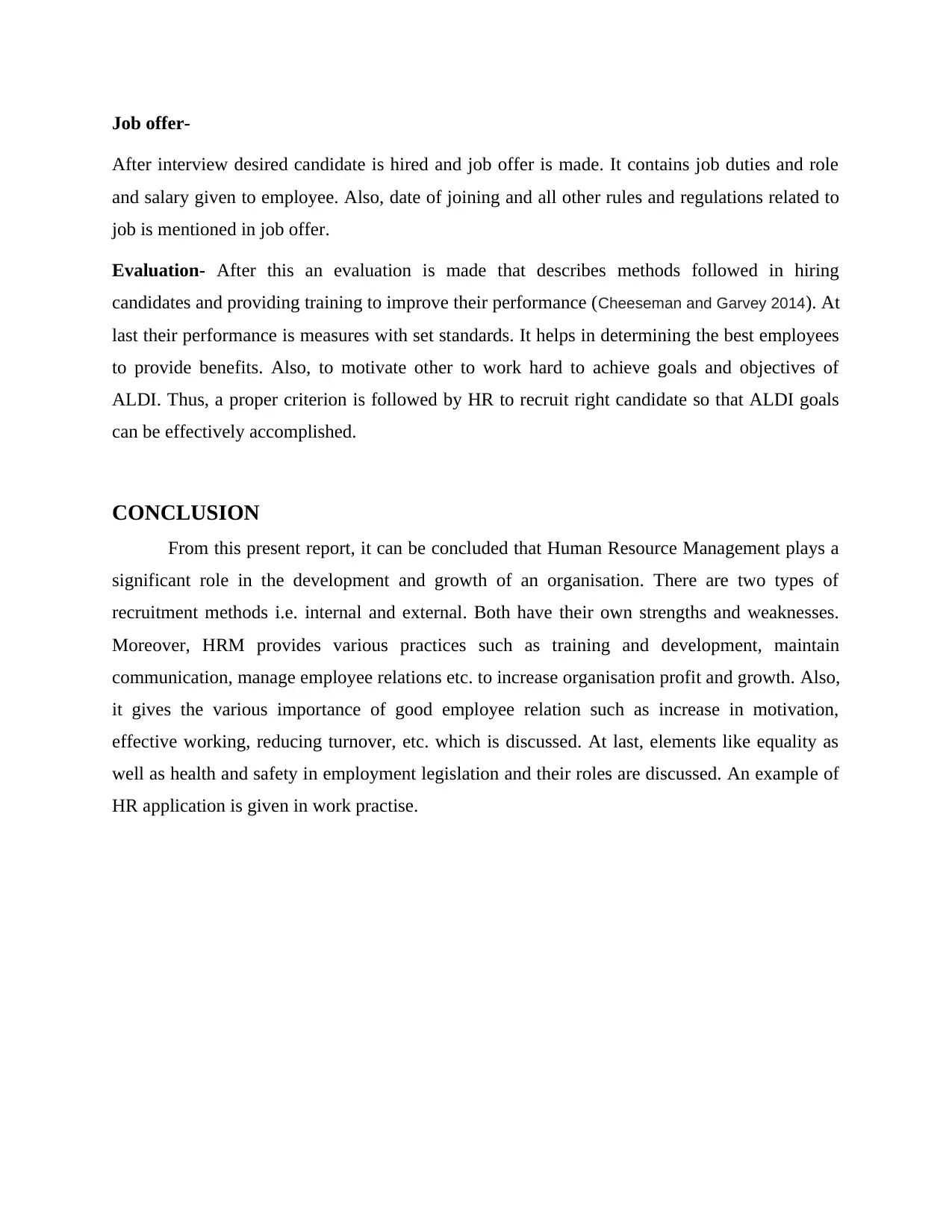
Job offer-
After interview desired candidate is hired and job offer is made. It contains job duties and role
and salary given to employee. Also, date of joining and all other rules and regulations related to
job is mentioned in job offer.
Evaluation- After this an evaluation is made that describes methods followed in hiring
candidates and providing training to improve their performance (Cheeseman and Garvey 2014). At
last their performance is measures with set standards. It helps in determining the best employees
to provide benefits. Also, to motivate other to work hard to achieve goals and objectives of
ALDI. Thus, a proper criterion is followed by HR to recruit right candidate so that ALDI goals
can be effectively accomplished.
CONCLUSION
From this present report, it can be concluded that Human Resource Management plays a
significant role in the development and growth of an organisation. There are two types of
recruitment methods i.e. internal and external. Both have their own strengths and weaknesses.
Moreover, HRM provides various practices such as training and development, maintain
communication, manage employee relations etc. to increase organisation profit and growth. Also,
it gives the various importance of good employee relation such as increase in motivation,
effective working, reducing turnover, etc. which is discussed. At last, elements like equality as
well as health and safety in employment legislation and their roles are discussed. An example of
HR application is given in work practise.
After interview desired candidate is hired and job offer is made. It contains job duties and role
and salary given to employee. Also, date of joining and all other rules and regulations related to
job is mentioned in job offer.
Evaluation- After this an evaluation is made that describes methods followed in hiring
candidates and providing training to improve their performance (Cheeseman and Garvey 2014). At
last their performance is measures with set standards. It helps in determining the best employees
to provide benefits. Also, to motivate other to work hard to achieve goals and objectives of
ALDI. Thus, a proper criterion is followed by HR to recruit right candidate so that ALDI goals
can be effectively accomplished.
CONCLUSION
From this present report, it can be concluded that Human Resource Management plays a
significant role in the development and growth of an organisation. There are two types of
recruitment methods i.e. internal and external. Both have their own strengths and weaknesses.
Moreover, HRM provides various practices such as training and development, maintain
communication, manage employee relations etc. to increase organisation profit and growth. Also,
it gives the various importance of good employee relation such as increase in motivation,
effective working, reducing turnover, etc. which is discussed. At last, elements like equality as
well as health and safety in employment legislation and their roles are discussed. An example of
HR application is given in work practise.
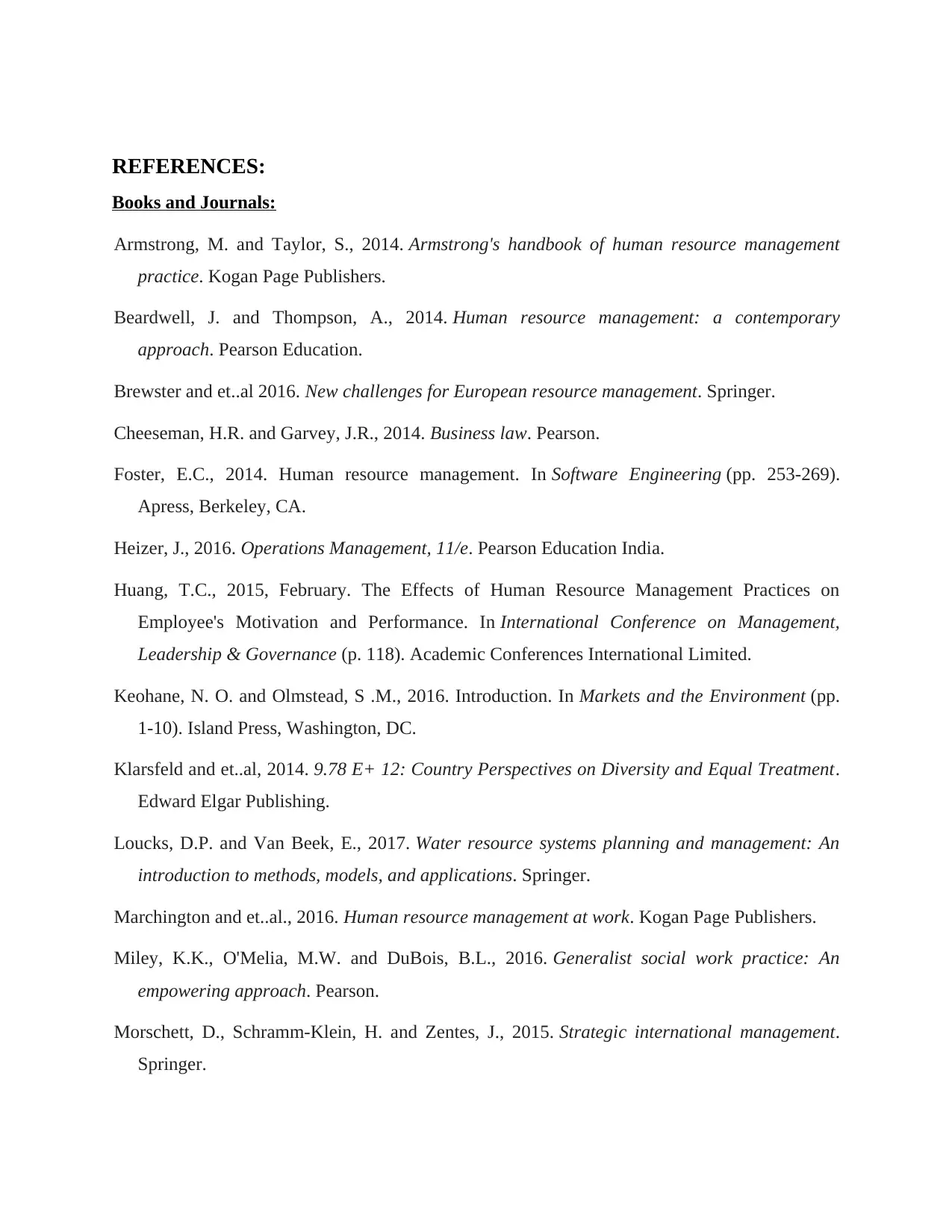
REFERENCES:
Books and Journals:
Armstrong, M. and Taylor, S., 2014. Armstrong's handbook of human resource management
practice. Kogan Page Publishers.
Beardwell, J. and Thompson, A., 2014. Human resource management: a contemporary
approach. Pearson Education.
Brewster and et..al 2016. New challenges for European resource management. Springer.
Cheeseman, H.R. and Garvey, J.R., 2014. Business law. Pearson.
Foster, E.C., 2014. Human resource management. In Software Engineering (pp. 253-269).
Apress, Berkeley, CA.
Heizer, J., 2016. Operations Management, 11/e. Pearson Education India.
Huang, T.C., 2015, February. The Effects of Human Resource Management Practices on
Employee's Motivation and Performance. In International Conference on Management,
Leadership & Governance (p. 118). Academic Conferences International Limited.
Keohane, N. O. and Olmstead, S .M., 2016. Introduction. In Markets and the Environment (pp.
1-10). Island Press, Washington, DC.
Klarsfeld and et..al, 2014. 9.78 E+ 12: Country Perspectives on Diversity and Equal Treatment.
Edward Elgar Publishing.
Loucks, D.P. and Van Beek, E., 2017. Water resource systems planning and management: An
introduction to methods, models, and applications. Springer.
Marchington and et..al., 2016. Human resource management at work. Kogan Page Publishers.
Miley, K.K., O'Melia, M.W. and DuBois, B.L., 2016. Generalist social work practice: An
empowering approach. Pearson.
Morschett, D., Schramm-Klein, H. and Zentes, J., 2015. Strategic international management.
Springer.
Books and Journals:
Armstrong, M. and Taylor, S., 2014. Armstrong's handbook of human resource management
practice. Kogan Page Publishers.
Beardwell, J. and Thompson, A., 2014. Human resource management: a contemporary
approach. Pearson Education.
Brewster and et..al 2016. New challenges for European resource management. Springer.
Cheeseman, H.R. and Garvey, J.R., 2014. Business law. Pearson.
Foster, E.C., 2014. Human resource management. In Software Engineering (pp. 253-269).
Apress, Berkeley, CA.
Heizer, J., 2016. Operations Management, 11/e. Pearson Education India.
Huang, T.C., 2015, February. The Effects of Human Resource Management Practices on
Employee's Motivation and Performance. In International Conference on Management,
Leadership & Governance (p. 118). Academic Conferences International Limited.
Keohane, N. O. and Olmstead, S .M., 2016. Introduction. In Markets and the Environment (pp.
1-10). Island Press, Washington, DC.
Klarsfeld and et..al, 2014. 9.78 E+ 12: Country Perspectives on Diversity and Equal Treatment.
Edward Elgar Publishing.
Loucks, D.P. and Van Beek, E., 2017. Water resource systems planning and management: An
introduction to methods, models, and applications. Springer.
Marchington and et..al., 2016. Human resource management at work. Kogan Page Publishers.
Miley, K.K., O'Melia, M.W. and DuBois, B.L., 2016. Generalist social work practice: An
empowering approach. Pearson.
Morschett, D., Schramm-Klein, H. and Zentes, J., 2015. Strategic international management.
Springer.
⊘ This is a preview!⊘
Do you want full access?
Subscribe today to unlock all pages.

Trusted by 1+ million students worldwide
1 out of 13
Related Documents
Your All-in-One AI-Powered Toolkit for Academic Success.
+13062052269
info@desklib.com
Available 24*7 on WhatsApp / Email
![[object Object]](/_next/static/media/star-bottom.7253800d.svg)
Unlock your academic potential
Copyright © 2020–2025 A2Z Services. All Rights Reserved. Developed and managed by ZUCOL.





